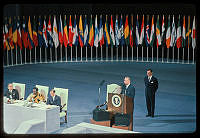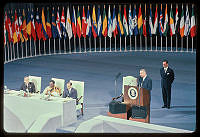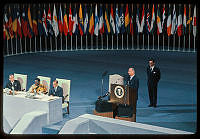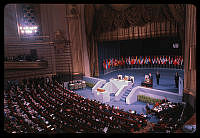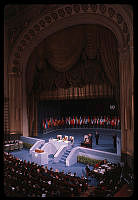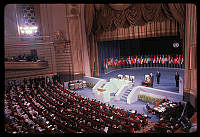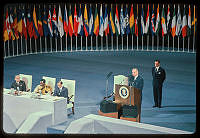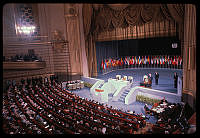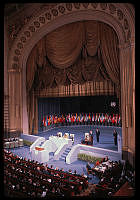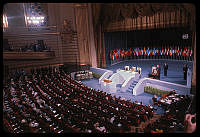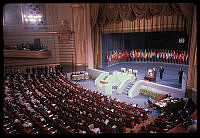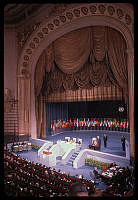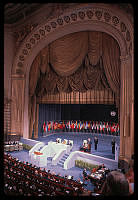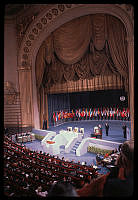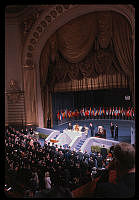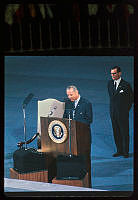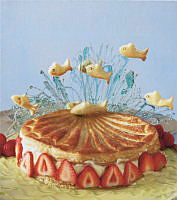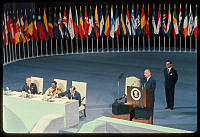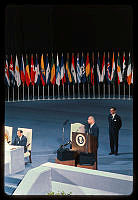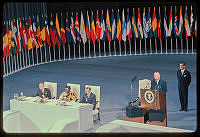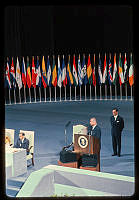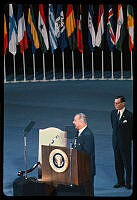Rubenstein Center Scholarship
The First Fan
Mrs. Coolidge's Passion for the Game
While both President Calvin Coolidge and First Lady Grace Coolidge were well known baseball supporters, not everyone realized that of the two, Grace Coolidge was by far the more knowledgeable and enthusiastic fan.
Bucky Harris, who managed the Senators during their great run of 1920s success, said she was “the most rabid baseball fan I ever knew in the White House.”1 (When Harris was married in October 1926, both the president and first lady attended the wedding.)2
Grace Coolidge attended as many games as she could, faithfully keeping track of the proceedings on her scorecard. To stay in close touch with her team while sailing down the Potomac on the presidential yacht Mayflower, she listened to Senators games on radio station WRC.3

President Calvin Coolidge and First Lady Grace Coolidge at a baseball game with Coolidge’s secretary C. Bascom Slemp at right, 1924.
The Senators clinched their first American League championship on September 29, 1924. Many D.C.-area fans were delighted that pitching great Walter Johnson – “bigger than the Washington Monument, broader than the Potomac River” – would have the first chance in his 18-year career to play in a World Series. (The Coolidges joined other fans in contributing $8,000 to buy Johnson a Lincoln limousine as a gift of appreciation.) With ticket dealers active on Pennsylvania Avenue’s “Scalpers Row” near the White House, city-wide excitement reached a fever pitch.4
On October 4, the Coolidges joined 35,760 fans for game one of the series. The score was tied 2-2 in the ninth inning when President Coolidge resolved that it was time to return to the White House. When he rose to leave, the first lady, resplendent in her “good luck” necklace of seven ivory elephants, snapped, “Where do you think you’re going? You sit down,” seizing his coattails to emphasize her point. Coolidge obeyed and stayed on to see the Giants win in extra innings.5
When Senators’ catcher Muddy Ruel crossed home plate with the winning run of the seventh and deciding game at 5:04 on the afternoon of October 10, Washington exploded with joy – “Armistice Day and Mardi Gras blended into one,” reported the New York Times. Exultant fans half-carried Walter Johnson to President Coolidge, who told him, “Nice work. I am glad you won.”
The first lady’s response was cheerier. “She jumped up and down with both feet,” said The Sporting News, “waved her arms, yelled, called out to Walter Johnson … The picture of sedateness on her arrival, she left as rumpled, as tired, and as happy as the thousands of other fans.”6

President Calvin Coolidge signs a baseball for Hall of Fame pitcher Walter Johnson as Johnson’s Senators teammates look on, 1924.
Both Coolidges were present at the Senators’ home opener on April 22, 1925, participating in what Francis P. Daily of the Washington Post called the “first collective siege of baseball heebee jeebies in the history of the nation’s seat of government.” The Senators reached the World Series again that season, but the result was a disappointment; they lost in seven games to the Pittsburgh Pirates (They would make only one more world series appearance – in 1933 – before leaving Washington for good in 1971.) The Coolidges attended game three in Washington, a 4-3 Senators victory, but had to listen gloomily on a radio in the White House as the Senators lost the deciding game in Pittsburgh.7

President Coolidge prepares to throw out the first ball of game three of the 1925 World Series; Pittsburgh Pirates manager Bill McKechnie stands to the president’s right and Washington Senators manager Bucky Harris stands on Coolidge’s left; baseball commissioner Kennesaw Mountain Landis is visible at Harris’ left shoulder, October 10, 1925.
After the Coolidges returned to their hometown of Northampton, Massachusetts in 1929, they transferred their allegiance from the Senators to the Boston Red Sox. Following her husband’s death in 1933, Grace Coolidge traveled the 100 miles from Northampton to Boston several times a year to watch the Red Sox play.
“It’s a lot of fun …,” she said. “I’m an American League fan and have been ever since we were in Washington and the Washington Senators won the pennant and the World Series.” She attended game three of the 1946 Red Sox-Cardinals World Series seated in a box along the first base line; however, photographers were far more interested in getting snapshots of the lady sitting behind her, movie star Rita Hayworth.8
“As soon as I venture an opinion on baseball or about a team,” she observed in 1949, “I get hundreds of letters from fans who agree or disagree with me. It’s really an awful burden. I don’t have a secretary and I have to answer the letters myself. … I’m over 70 now. I feel I’ve done my part. I just want to enjoy a baseball game now and then without attracting a lot of attention.”9

From left to right: Treasury Secretary Andrew W. Mellon, First Lady Grace Coolidge, President Calvin Coolidge, Secretary of State Frank B. Kellogg and Attorney General John G. Sargent on Senators’ home opening day, April 22, 1925.
At a father-son baseball dinner at Northampton in November 1948, the featured speaker, Philadelphia Athletics pitcher Joe Coleman, was asked if an unassisted triple play had ever taken place during a World Series. Flustered, Coleman admitted he didn’t know the answer. At that moment a voice spoke up from the audience:
“Yes, Bill Wambsganss, Cleveland infield, in the 1920 series.” The voice belonged to Grace Coolidge, and she was exactly right.10













